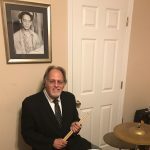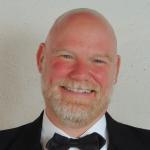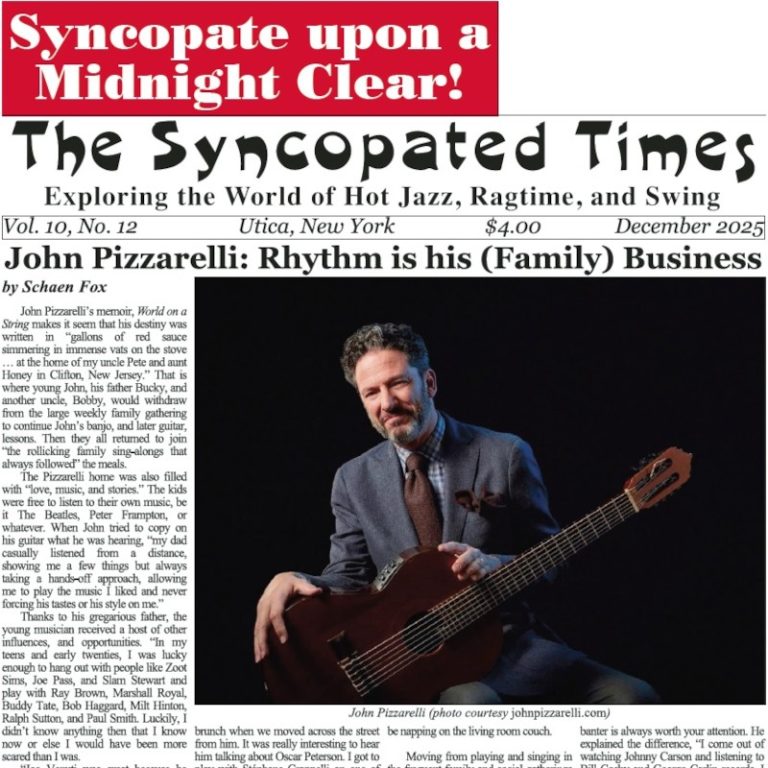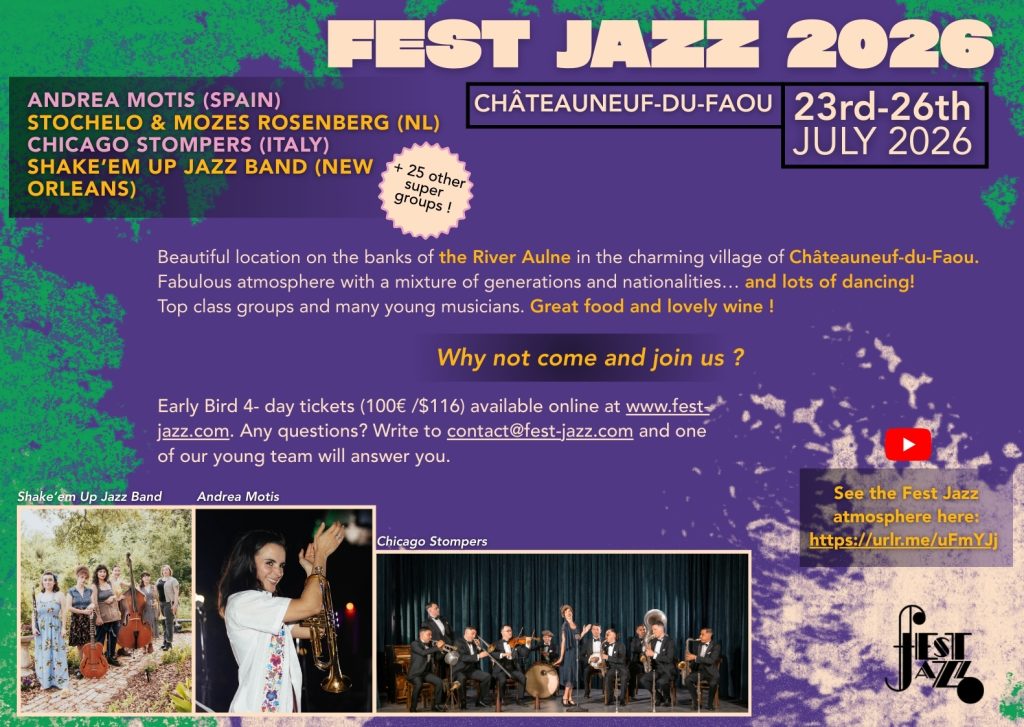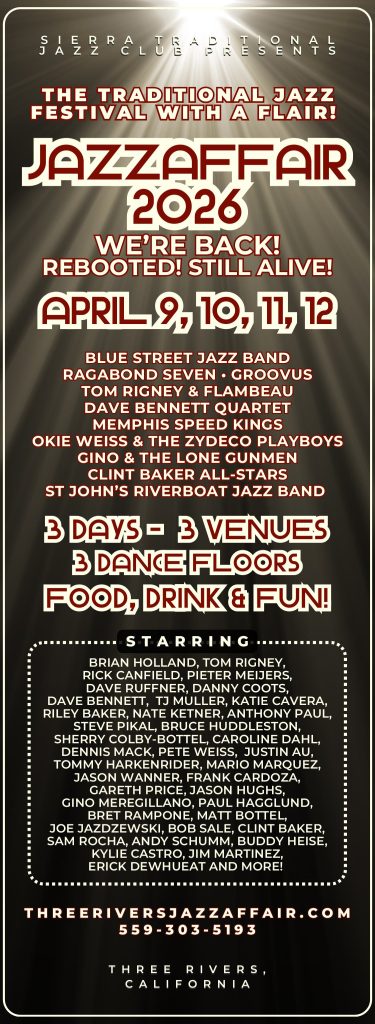In the previous issue of The Syncopated Times, we explored the similarities and (copious) differences between recordings of “Panama” made during the 1920s and 1930s. Variations on the routine continued on records made from the 1940s into the 1960s…
JB: Hal, as promised, we are going to launch Part II with two contrasting versions by Jelly Roll Morton. In 1938, he performed a solo piano rendition for the Library of Congress. We’ve both lamented that he stops after the first two strains, but aural riches abound in the two extant minutes of music. Highlights to me are the medium tempo and loose, loping feel Morton attains and maintains. Absent is the increase in tempo that characterize many of Morton’s earlier solo piano recordings. This moderate tempo allows him to include incredibly complex syncopation in the left hand, mirroring the almost ethereal figures in the right, while never abandoning an earthy, stompy feel. Brilliant!
Two years later in Manhattan, he led a septet through a frenetic, rather haphazard version. An incredible line-up—including Henry “Red” Allen, Albert Nicholas, Wellman Braud, and Zutty Singleton among others—never seems to gel; after playing the A and B section once each, Allen tries to repeat the B section while the rest of the band returns to A, resulting in a dropped bar. The band stumbles into the third section, albeit quickly recovering. Fortunately, Morton takes the second C as a solo, bringing the band to section D, with ensembles sandwiching the clarinet solo. Two blaring out choruses, a short ending and the whole thing finishes up in two-and-a-half minutes. What was supposed to be Morton’s triumphant comeback in the Big Apple became a big mess, and you mentioned to me that this was the more sympathetic line-up Morton had in New York. Hal, any thoughts on these before you introduce your first version for Part II?
HS: I’m with you on the Library of Congress recording. I would trade a lot of the other things Morton recorded on the Alan Lomax sessions for a complete “Panama!” The band version has always puzzled me. Morton wanted his bands to sound rehearsed on their recording sessions and trumpeter Henry “Red” Allen was one of the most knowledgeable musicians ever concerning New Orleans music. How and why he got lost and—more curiously—why another take was not recorded will have to remain a mystery. As you say, at least we get to hear a whole chorus of Morton at the piano, with Wellman Braud on bass and Zutty on drums!
The next recording in our chronological list is Henry “Kid” Rena’s, from 1940. His version includes the introduction, two each of the A and B strains in Eb, two C strains in Ab—all ensemble— then D with two clarinet solos and another by “Big Jim” Robinson on trombone before the ensemble takes it out on another run through D. Though the band doesn’t generate the same kind of excitement as Bunk’s, Ory’s or George Lewis,’ it is still a very interesting performance; especially as it was recorded just before the official start of the New Orleans Revival.
JB: I love the tempo on this, Hal! It shows that true New Orleans music is never about a fast tempo but always about the right feel. Rena lived another nine years after making this recording and spent some of the time leading up to 1940 and afterwards being jealous of Louis Armstrong, who was a few years younger; they had been together in the Colored Waif’s Home for Boys as children in New Orleans. While Rena plays a solid lead on this recording, I agree this version doesn’t lift you out of your seat. Interestingly, King Oliver offered the second cornet chair (and resultant relocation to Chicago) for his Creole Jazz Band to both Bunk Johnson and “Kid” Rena (in that order) before offering it to Armstrong!
Mentioning Bunk would naturally lead us to his recordings of “Panama,” but, as we unearthed four separate performances Johnson made between 1942 and 1944 that contrast enough, we contemplated revisiting this topic for a future column to showcase these versions. Does that still sound OK with you?
HS: Yes, that’s a good idea – especially since all of those versions have unique characteristics.
JB: Then our next performance, led by trumpeter Wild Bill Davison, is made up of the Condon mob (George Brunies (tb); Pee Wee Russell (cl); Gene Schroeder (p); Eddie Condon (g); Bob Casey (sb); George Wettling (dms). Besides the authoritative playing throughout—highlighted by Russell’s second solo chorus (NO ONE sounded like that but him!), Schroeder’s elegant, swinging piano choruses, and Brunies (regrettably) single solo chorus—this performance stands out to me for two reasons. First, the final four bars of section A are reharmonized with an arranged two-bar riff over a descending diminished chord. Second, the tag ending that has since become de rigueur is played twice to finish out.
HS: Davison’s record is red-hot! I always liked that descending diminished chord on the A strain – especially since the Firehouse Five played it on their version.
The next version in our chronological list is by Kid Ory’s Creole Jazz Band, recorded in 1945. “Papa Mutt” Carey plays a slight variation on the introduction, followed by two ensemble A and C sections. Next are three Ds, with Albert Nicholas soloing and the horns riffing underneath the second and third times. The ensemble plays two more Ds, with Mutt playing another variation on the melody and Ory playing a beautiful trombone line behind him—all backed by that wonderful rhythm section of Buster Wilson, Bud Scott, Ed Garland and Minor Hall. It’s quite a different feel from Wild Bill’s record and it also happens to be one of my favorites. Jeff, what did you hear on this version that stands out?
JB: I hear beautiful interaction between the horns during the ensembles! No one in the front line overplays; each line is clean, supportive, and always exciting and swinging. This is polyphonic jazz at its zenith! It’s interesting to compare Nicholas’ solos between this and the 1940 Morton version. He only gets one chorus in the Morton and chooses to stay in the chalumeau register throughout—perhaps an attempt to counter the chaos of the ensembles? Although Ory’s version is a mere 17 seconds longer, Nicholas is offered 3 choruses (30% of the entire performance) and he plays with an intensity that never abates, sprinkling classic New Orleans clarinet figures throughout. In a live performance, I can see an audience leaping to its feet in response to those solo rides, aided mightily by the rhythm section and the exciting backing provided by Ory and Carey. Anyone learning how to play cohesive New Orleans jazz would do well to start right here.
Nicholas represents a good bridge between our 1943 Davison and our 1945 Ory as he was also included in the performance from Vol. 5 of the “This is Jazz” broadcasts, again with Wild Bill as de facto leader. On this 1947 broadcast, Nicholas’ solo starts low and simmering, then builds heat during the second chorus. Although things go awry on Wild Bill’s second solo chorus (he drops a beat coming out of his first one), James P. Johnson is on hand to muscle things back into place with some power chords—in contrast to the delicate stride choruses he earlier provides. Two hot ensemble choruses (again doubling the traditional 8-bar tag) conclude with Baby Dodds’ punctuation on choke cymbal and everyone is safe!
I kept my description of this “Panama” lagniappe short because I am eager to get to our next planned version, Hal, and there is no-one alive more suited to share it with us! Let’s head to San Francisco!
HS: When I first heard the 1946 recording by Lu Watters’ Yerba Buena Jazz Band, I was confused! It didn’t sound anything like the Firehouse Five record, which was the only one I had at the time. However, I sure like the YBJB version! Lu dispensed with the traditional introduction and went right to the A strain, in the standard key of Eb. The ensemble plays A and D twice and E once, then opens up E for solos by clarinet, trumpet (Lu) and trombone. A key change to Ab brings the full ensemble back to D and two out choruses with a double ending instead of the tag. This is the “classic” version of the Yerba Buena band: Lu and Bob Scobey, trumpets; Turk Murphy, trombone; Bob Helm, clarinet; Wally Rose, piano; Harry Mordecai, banjo; Dick Lammi, tuba; and Bill Dart, drums.
I could write an entire article about the way THIS band played, but will save that for another time. However, I will point out that once the listener is familiar with the stylistic differences between Lu and Scobey, it is easy to hear who is playing lead and who is on second on the various strains. In this case, Lu plays lead on the first two D strains and the trumpet solo. Scobey plays lead on the other ensemble choruses while Lu is on second trumpet. The YBJB continued to use this basic arrangement at Hambone Kelly’s, though the solos depended upon who was in the band at the time – since the personnel changed several times before Lu disbanded in 1950.
Jeff, the next version in our queue offers quite a contrast to the Yerba Buena Jazz Band’s. Please tell us about this famous 1950 recording.
JB: It’s remarkable that our choosing to explore “Panama” through chronological interpretations placed the two most disparate readings back-to-back. Louis Armstrong’s All-Stars (Armstrong (tpt); Jack Teagarden (tmb); Barney Bigard (cl); Earl Hines (pno); Arvell Shaw (bs); Cozy Cole (dms)) treat us to the fastest tempo and longest version we have yet encountered. As you pointed out above, I could write an entire article, not just about this line-up of the All-Stars, but of this one performance!! Anyone who remarks about Louis’ perceived commercialism after the 1920’s is invited to have a listen and begin a lifetime of reevaluation.
Watters skipped the intro, but we get TWO piano intros here from Hines. The band launches into section D in Ab and stays there throughout. Two ensembles lead us into solos (three choruses each): Hines’ leave me breathless; Shaw’s three mightily swing; Bigard’s three mellifluously sing (the latter two backed with intensifying brass riffs); Pops charges in with impeccable phrasing and tone (so nothing unexpected); Teagarden lip-trills with abandon. We head into the final 2 choruses wondering how they can keep up this pace, Cole romps through a 4-bar drum tag and the band lands on an extended chord with Louis on a perfect HIGH concert Eb. Hal, I’m sure you have some observations about this version, or any of Armstrong’s alternate rides…
HS: The All-Stars used this basic routine on some live recordings, too. One in particular – a broadcast from Hollywood in March, 1949 – features some extraterrestrial piano by Hines and a drum tag by Big Sid Catlett that every drummer I know would like to be able to replicate! On the 1959 “Satchmo Plays King Oliver” record, the All-Stars began the song with a drum cadence and roll-off instead of the piano solo. The tempo was substantially slower, but the routine was similar to the 1950 record.
Moving forward to 1953, we have a magnificent version of “Panama” by Turk Murphy’s San Francisco Jazz Band. They play the traditional introduction, A ensemble, B trombone and clarinet duet, A ensemble – all in Eb – then two ensemble C strains (in Ab), D ensemble, D solo (clarinet 2x, trumpet 1x, trombone 2x), D ensemble and a loose D out with a double ending. Turk continued to use this same routine (adding another cornet or trumpet chorus).
I absolutely love everything that Turk, Don Kinch and Bob Helm play on this record. Does it affect you the same way, Jeff?
JB: Turk’s music was my earliest exposure to traditional jazz, so I was grinning from ear-to-ear. The brassiest sound possible emanated from Murphy’s trombone, smearing and tugging at those notes. I’d forgotten how hot Kinch could play (and how influential he was to future generations playing San Francisco style, from Schulz to Comins, Oakley and more). And Helm is wailing away, bending notes and getting himself into places you think he’ll never escape, but he always does! With that rock-solid rhythm, excuse me saying that I don’t miss the drums here, Hal. This is take-no-prisoners, brash, bare-knuckled, stevedorean (my word) jazz!
For another contrast, let’s examine two George Lewis performances (1953, 1959). 1953 sees Lewis joined by Kid Howard (tpt); Jim Robinson (tb); Alton Parnell (pno); Lawrence Marrero (bjo); Alcide “Slow Drag” Pavageau (sbs); and Joe Watkins (dms). The band plays ensembles of all of Tyers’ sections twice each, so the first half of this performance is pure New Orleans polyphony at its best! After a single 2-chorus solo by Purnell (shuffle-beating away with abandon), 3 ensembles on the D strain take us out, or so we think! The expected 4-bar drum tag leads into another ENTIRE ensemble D chorus! YOWZA!
The 1959 version has some different personnel and frankly did not sound as successful to me, with a weaker trumpet lead, intonation and tuning issues, some chord disagreement in the C section. A bonus is hearing Lewis’ two solo choruses as well as Bob Mielke’s tailgating! Hal, what are your thoughts regarding these Lewis performances?
HS: I agree with you on all counts, Jeff. That 1953 recording is a good illustration of why so many American and European musicians latched onto the George Lewis band as an inspiration for their own playing. I like that full chorus after the drum tag, too. That’s a real, authentic New Orleans device that has gone by the wayside in recent years. The 1959 record doesn’t do much for me except for Lewis’ playing and of course the always-wonderful trombone playing by Bob Mielke. I notice that, starting around 1953, some records label the song as “Panama Rag.” I’m not sure whether George Lewis started that, or if it came from another source. But Tyers’ composition (without “Rag” in the title) has nothing to do with the two “Panama Rag” compositions by Cy Seymour and William Polla!
JB: Yeah, somehow record labels (or bandleaders) started adding “Rag” to the title, perhaps because Tyers’ solo piece was published during the ragtime era. Potential for confusion is rife; the left-hand “Spanish Tinge” accompanies ragtime rhythms in the right hand, and the entire piece is labeled “A Characteristic Novelty!” It’s easy to see how people 40 years later were getting confused.
An even more confusing, but FANTASTIC, rendition was provided by Billy May and his Orch. In 1955, his “Sorta-Dixie” album featured a Chicago style front line—Dick Cathcart (tpt); Matty Matlock, (clt); Moe Schneider (tmb); Eddie Miller (tn, sax)—and a 22-piece orchestra, many of them hot jazz household names as well! I must quote the list of instruments played by the two percussionists during the recording of this album, Hal; I hope next time we meet you’ll have all this stuff: “conventional drums, orchestra bells, xylophone, marimba, wood blocks, gong, temple blocks, tympani, finger cymbals, triangle.”
This mish-mash of styles and ideas shouldn’t work, but is does, thanks to the precise, enthusiastic playing of everyone involved and May’s arranging genius. Fluid styles, key changes (sometimes in the middle of strains), the mystery “E” section, and a flipping back and forth between orchestra passages in 4/4 and “the Dixielanders” (liner note term) in 2/4 add up to an exhilarating performance. Hal, any thoughts about this sui generis romp?
HS: When I heard the first chorus, with the key changing every four bars, I wondered if it might have been taken from a cassette that had been left too long in a hot car. I guess that’s a clever effect, and I know the musicians on the session were great…but my tastes are a lot closer to the other versions we have been discussing!
JB: Fair enough! I laughed out loud at that “hot car” image. What’s next?
HS: The next record of “Panama” is “different” too, but I have always loved Bob Scobey’s version, recorded in 1956. I have heard live recordings of by Scobey with similar routines to Turk’s and Lewis,’ but this one is unusual in that it features drummer Fred Higuera – on brushes!
The band starts with the traditional introduction, then two As, one B (all in Eb) by the ensemble, key change to Ab, two Ds (ensemble), D (solo by clarinetist Bill Napier), D three times with stoptimes for Fred, then two ensemble Ds with an extended ending. The fantastic drumming, Bill Napier’s beautiful clarinet, Scobey’s swinging trumpet and tuba man Bob Short’s perfect bass lines just knock me out. It’s enough for me to forgive Scobey for labeling it “Panama RAG!” What elements of this recording appeal to you, Jeff?
JB: The brushes make this version sparkle. You can hear every instrument clearly and there is a buoyancy contrasting with Watters’ and Murphy’s heavy beat and brashness. Hearing this version, I was musing how influential Scobey might have been to the Brit band leaders such as Acker Bilk, Kenny Ball and Chris Barber. We should consider looking into this possibility in greater detail in the future! Including a lengthy recorded drum solo was a brave thing to do, but it worked because of Higuera’s inventiveness. Hal, this next one is (justifiably) one of your very favorites—and mine!
HS: This is the version of “Panama” that started it all for me: the 1957 record by the Firehouse Five Plus Two; one of the first records I owned by the band and the first record of “Panama” that I ever heard! You know, so many of the songs on their “theme” albums never made it out of the studio and onto the bandstand. But the FH5+2 played “Panama” a LOT. I heard them play it in person at Disneyland on several occasions.
They might have added an extra chorus for the horn soloists (or more, for George Probert on soprano), but I recall hearing this basic routine: Intro, ensemble A (with the descending line at the end) 2x, in Eb; C ensemble (Ab); D (solos: soprano sax, cornet, banjo, trombone, tuba, piano); D ensemble, D (loose) ensemble with an extended ending. This is one of my all-time favorite records of “Panama” – especially for the solos by Probert, Danny Alguire, Dick Roberts, Ward Kimball, George Bruns and Frank Thomas. Listening to it just now, I remember how exciting it was to hear this exact same band playing “Panama” LIVE when I was eight years old!
JB: Such a terrific image of you as a tyke soaking in the righteous sounds that would help influence your entire life, Hal! Beautiful. Beyond agreeing that I love this joyful rendition, I can’t add a thing, so I’ll take us back to NOLA. 1958’s performance by the original Dukes of Dixieland finds the Assuntos and company in typical strong fettle, with an economic presentation of the form (A and B in Eb, 1x each; C and D in Ab, 1x each) solos on “E” (Ab: clarinet 2x; trombone (Fred) 1x; trumpet (Frank) 1x; piano 1x; trombone 1x (Papa Jac); two ensembles out with a short ending. Ebullient, effortless, swinging. I love how Bill Porter would play tuba on the ensembles and switch to string bass during the solos. What are your thoughts, Hal?
HS: The Dukes’ version really is terrific (even if it’s labeled as “Panama RAG,” with a different composer credit)! “Economic” is a good description and I also like the switch from tuba to string bass back to tuba. The solos – especially by Jack Maheu on clarinet and Stanley Mendelson on piano – are very nice. Frank’s bouncy trumpet playing reminds me of Bob Scobey’s style.
You know, we could keep this analysis going right up to the present time, as contemporary traditional jazz bands still record “Panama.” But for space reasons, I think we ought to conclude with a record from 1966 that had a profound effect upon both of us: “Panama” by the Original Salty Dogs. I definitely want to comment on this, but first…what do you think makes this such a great performance, Jeff?
JB: This version (and the entire “Free Wheeling” album) finds the “Dogs” at their apex! Precision, heat, a rhythm section—John Cooper, (pno); Jack Kuncl (bjo); Mike Walbridge (tuba); Wayne Jones (drums)—that is PERFECTLY locked in, a supremely cohesive front line—Lew Green (cnt); Kim Cusack (reeds); Jim Snyder (tmb)—dynamics, suspense, four out choruses…the only thing missing is dancing girls!! I saw this band live in 1988, with South with Tom Bartlett having replaced Snyder on trombone; the band still had that drive! Bring us home with your views on this seminal rendition, Hal!
HS: One of the first things that comes to mind is the late Frank Powers’ comment that the Salty Dogs at this time had “the Cadillac of rhythm sections.” That’s so true! I admire the fantastic drive they achieved without increasing the decibels. And of course Wayne Jones was my earliest mentor. I am so glad that I got to hear the Original Salty Dogs live, on a number of occasions (and to fill in for Wayne a couple times, too)! The band was always a world-class ensemble and they have inspired many young musicians – such as Andy Schumm and Jim Barrett — who are working with the current edition of the band, still led by Lew Green.
JB: A final observation brings us full circle: the Dogs include 2 ensemble choruses of that mystery section “E” before we hear sections C and D, making it, perhaps for the first time, an integral part of the form of the piece rather than a phantom melody.
HS: This recording was the first time I heard the “mystery” (E) strain and also the first traditional jazz record in my collection with solo choruses on alto sax! Regrettably, we need to bring this discussion to a close and start thinking about our next column. What’s on your mind, Jeff?
JB: Next month, we’ll be inviting musician and scholar extraordinaire Colin Hancock to join us in our discussion about trumpeter Sterling Bose (who appeared in our Feb. column on the Bob Cats). As a bonus, Bose’s great-niece Jan Ostrom will join us for some “inside” stories!
End Note: Just as we finished this article, we heard from esteemed jazz historian and writer Paige Van Vorst, with information concerning the “mystery” strain we’ve been discussing. Paige writes:
Reading your Panama article in TST- fascinating, of course, as there are few numbers I like better than that one. As to the E strain, my guess would be that it came from Fess Manetta. Charlie Devore always told me that Fess wrote out a chorus on the tune for Emmett Hardy and that it became part of the tune. Certainly Hardy would have been influential on the NORK and Manetta would have been capable of stealing pieces from common-property New Orleans tunes.
Thank you, Paige and Charlie Devore! This explanation makes perfect sense!
Hal Smith is an Arkansas-based drummer and writer. He leads the El Dorado Jazz Band and the
Mortonia Seven and works with a variety of jazz and swing bands. Visit him online at
halsmithmusic.com
Jeff Barnhart is an internationally renowned pianist, vocalist, arranger, bandleader, recording artist, ASCAP composer, educator and entertainer. Visit him online atwww.jeffbarnhart.com. Email: Mysticrag@aol.com

